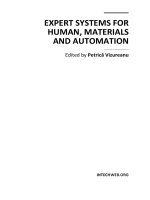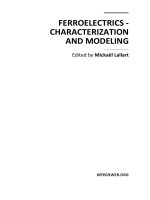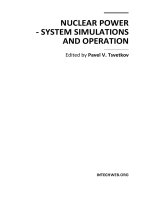transformer engineering design and practice 1_phần 1 pdf
Bạn đang xem bản rút gọn của tài liệu. Xem và tải ngay bản đầy đủ của tài liệu tại đây (113.94 KB, 6 trang )
453
Appendix A: Fault Calculations
In this appendix, asymmetrical fault calculations for a transformer are given. A
single-line-to-ground fault on LV side is considered. The neutrals of LV and HV
windings are solidly grounded. Two distinct cases are considered, viz. with and
without fault in-feed from the secondary (LV) side. For each of these two cases, two
conditions are considered, viz. with and without stabilizing tertiary winding (TV).
The effects of omitting tertiary winding are illustrated with these cases.
Transformer Data:
Rating (S)=25 MVA, Core construction: three-phase three-limb
Voltage ratio: HV/LV/TV, 132/11/11 KV, star/star/delta
Leakage sequence impedances (based on 25 MVA base):
HV/LV:Z
1
=Z
2
=12%, Z
0
= 10.2%
HV/TV:Z
1
=Z
2
=20%, Z
0
=17.0%
LV/TV: Z
1
=Z
2
=6%, Z
0
=5.4%
132 KV system fault level (S
F
)=5000 MVA
The positive-sequence system impedance on the HV side is Z
1HS
=0.5% (calculated
by equation 6.2). The HV and LV side systems are assumed as effectively
grounded systems (X
0
/X
1
not greater than 3). Here, in particular, the zero-sequence
system impedances on the LV and HV sides are assumed to be equal to the
corresponding positive-sequence system impedances for simplicity. As
mentioned earlier, two alternatives are considered for 11 KV (LV) system:
(i) Without any fault in-feed from 11 KV system.
(ii) With fault in-feed from 11 KV system:
Copyright © 2004 by Marcel Dekker, Inc.
Appendix A454
11 KV system fault level (S
F
)=833.33 MVA, which gives the positive-
sequence system impedance on LV side: Z
1LS
=3.0% (by equation 6.2).
The equivalent impedances in the star equivalent circuit can be computed by
using the theory given in Section 3.5 (Chapter 3) as
ZH=(Z
HL
+Z
HT
-Z
LT
)/2
Z
L
=(Z
HL
+Z
LT
-Z
HT
)/2
Z
T
=(Z
HT
+Z
LT
-Z
HL
)/2
Therefore, the corresponding positive-, negative- and zero-sequence impedances
of HV, LV and TV windings are computed as follows:
Z
1H
=Z
2H
=(12+20-6)/2=l3%, Z
0H
=(10.2+17-5.4)/2=10.9%
Z
1T
=Z
2T
=(20+6-12)/2=7%, Z
0T
=(17+5.4-10.2)/2= 6.1%
A1 Asymmetrical Fault with No In-Feed from LV Side
A1.1 Delta connected tertiary winding is present
The equivalent network under the fault condition is shown in figure A1 for a
single-line-to-ground fault on the LV side. All the impedances are in % values.
taken to be effectively infinite since there is no in-feed from the LV side.
Figure A1 Sequence network for Case A1.1
Z
1
L=Z
2L
=(12+6-20)/2=-l%, Z
0L=
(10.2+5.4-17)/2 =-0.7%
The network can be derived from figure 6.3 (a) with impedances Z
1LS
, Z
2LS
and Z
0LS
Copyright © 2004 by Marcel Dekker, Inc.
Appendix A 455
Total impedance=2(0.5+13–1)-0.7+(11.4//6.1)=28.27%
For a single phase-earth fault, using equations 6.6 and 6.7 we get the values of
sequence components of currents as
I
1
=I
2
=I
0
=100/28.27=3.54 p.u. (i.e., 3.54 times the rated current).
Total fault current=I
1
+I
2
+I
0
=3(3.54)=10.62 p.u.
The fault current in any of the windings is calculated by adding the corresponding
sequence currents flowing in them in the three sequence networks. The neutral of
LV and HV windings carries 3 times the corresponding zero-sequence current
flowing in them. Therefore,
Current through HV winding=3.54+3.54+3.54 (6.1/17.5)=8.31 p.u.
Current through LV winding=3.54+3.54+3.54=10.62 p.u.
Current through stabilizing winding=3.54 (11.4/17.5)=2.31 p.u.
Current through HV neutral=3×3.54 (6.1/17.5)=3.7 p.u.
Current through LV neutral=total fault current=3×3.54 =10.62 p.u.
A1.2 Delta connected tertiary winding is absent
The equivalent network under the fault condition is shown in figure A2 for a
single-line-to-ground fault on the LV side. Proceeding in the similar way as in
Section A1.1 we get
Total Impedance=2(0.5+13–1)-0.7+0.5+10.9=35.7%
Figure A2 Sequence network for Case A1.2
Copyright © 2004 by Marcel Dekker, Inc.
Appendix A456
I
1
=I
2
=I
0
=100/35.7=2.8 p.u.
Total fault current=I
1
+I
2
+I
0
=3 (2.8)=8.4 p.u.
Current through HV winding=2.8+2.8+2.8=8.4 p.u.
Current through LV winding=2.8+2.8+2.8=8.4 p.u.
Current through HV neutral=8.4 p.u.
Current through LV neutral=8.4 p.u.
It is to be noted that the single-line-to-ground fault current in this case (8.4 p.u.) is
more than the three-phase fault current (i.e., 1/Z
1
=1/0.12=8.33 p.u.) due to two
reasons. First, the zero-sequence leakage impedance of the transformer is less than
the positive-sequence leakage impedance. Second, it is assumed that the positive-
and zero-sequence system impedances of HV side are equal (0.5 p.u.). In many of
the cases, the system zero-sequence impedance is more than the positive-
sequence impedance, which will make the single-line-to-ground fault current
lower than the three-phase fault current.
It can be observed from the above two case studies that the absence of the
tertiary stabilizing winding reduces the total fault current and the current in the
faulted winding (LV). However, the current in HV neutral increases significantly.
Figure A3 Sequence network for Case A2.1
Copyright © 2004 by Marcel Dekker, Inc.
Appendix A 457
A2 Asymmetrical Fault with In-Feed from LV Side
A2.1 Delta connected tertiary winding is present
The equivalent network under the fault condition is shown in figure A3 for a
single-line-to-ground fault on the LV side. The network is same as that given in
figure 6.3.
Total positive-sequence impedance=12.5//3=2.42%
Total negative-sequence impedance=12.5//3=2.42%
Total zero-sequence impedance=[(11.4//6.1)-0.7]//3=1.56%
Total impedance=2.42+2.42+1.56=6.4%
I
1
=I
2
=I
0
=100/6.4=15.62 p.u.
Total fault current=I
1
+I
2
+I
0
=3 (15.62)=46.86 p.u.
Current through HV winding
=15.62(3/15.5)+15.62(3/15.5)+15.62(3/6.27)(6.1/17.5)
=3.02+3.02+2.6=8.64 p.u.
Current through LV winding=3.02+3.02+15.62(3/6.27)=13.51 p.u.
Current through stabilizing winding=15.62(3/6.27)(11.4/17.5)=4.87 p.u.
Current through HV neutral=3×2.6=7.8 p.u.
Current through LV neutral=3×7.47=22.41 p.u.
Figure A4 Sequence network for Case A2.2
Copyright © 2004 by Marcel Dekker, Inc.
Appendix A458
A2.2 Delta connected tertiary winding is absent
The equivalent network under the fault condition is shown in figure A4 for a
single-line-to-ground fault on the LV side. Proceeding in the similar way as in
Section A2.1 we get
Total positive-sequence impedance=12.5//3=2.42%
Total negative-sequence impedance=12.5//3=2.42%
Total zero-sequence impedance=10.7//3=2.34%
Total Impedance=2.42+2.42+2.34–7.18%
I
1
=I
2
=I
0
=100/7.18 7.18=13.93 p.u.
Total fault current=I
1
+I
2
+I
0
=3(13.93)=41.79 p.u.
Current through HV winding
=13.93(3/15.5)+13.93(3/15.5)+13.93(3/13.7)
=2.7+2.7+3.05=8.45 p.u.
Current through LV winding=2.7+2.7+3.05=8.45 p.u.
Current through HV neutral=3×3.05=9.15 p.u.
Current through LV neutral=3×3.05=9.15 p.u.
It can be observed from the above two case studies (in-feed from LV side) that the
absence of the tertiary stabilizing winding reduces the total fault current and the
current in the faulted winding (LV). The current in HV neutral increases.
Copyright © 2004 by Marcel Dekker, Inc.









